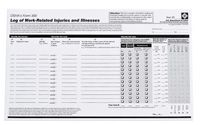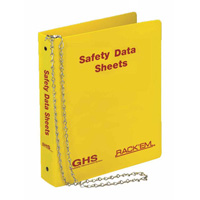| The Home page of ILPI's Safety Data Sheet (SDS) Resource, the leader in SDS information since 1995! | |
| The history and philosophy behind this resource. | |
| A curated collection of books and reference materials concerning Safety Data Sheets and closely related topics. | |
| Paste your plain text SDS into the SDS-Demystifier, and it will be converted into a hypertext-enriched document with links to detailed explanations of each key term. | |
| An extensive list of frequently asked questions about Safety Data Sheets including regulations, content, compliance, and more. | |
| A humorous take on Safety Data Sheet jargon. Fill in the blanks on our entry form to generate a personalized Unsafety Data Sheet to share with your coworkers. | |
| Since 1995, we've maintained this massive curated list of the best places to find Safety Data Sheets on the Internet. | |
| You are here! Way more than a glossary, this hypertext-enhanced resource covers hundreds of SDS-related terms and expert knowledge. Each entry includes both the SDS relevance and links to additional authoritative resources. | |
| Archived results of Safety Data Sheet related polls taken by some of our millions of site visitors | |
| The OSHA regulations behind SDS regulations, including the inspection guidelines and over 400 official interpretations letters under the Hazard Communication Standard | |
| Commercial suppliers of SDS authoring and management software as well as cloud compliance services. | |
| Commercial companies that will create SDS's for your specific needs as well as SDS translation companies. |

Safety signs, banners, and scoreboards? Get yours at Safety Emporium!
Definition
The U.S. Occupational Safety and Health Administration, OSHA, is a federal government agency in the U.S. Department of Labor. OSHA's web site is https://www.osha.gov.
The primary goals of OSHA are to save lives, prevent injuries and protect the health of America's workers. OSHA employs over 2,000 inspectors to ensure job site safety.
Additional Info
OSHA was created by the Occupational Safety and Health (OSH) Act of 1970.

Take care of your OSHA 300 reporting obligations with these ready-to-fill forms from Safety Emporium.
While many see OSHA as an intrusive government agency intent on enforcing arcane rules, a 2012 study published in the prestigious research journal, Science, showed that OSHA saves lives and jobs. Before OSHA was established, an estimated 14,000 US workers were killed on the job every year. While workplaces today are much safer and healthier, in the US there are still more than 5,000 workplace fatalities each year and tens of thousands serious injuries. That's one reason OSHA offers a Voluntary Protection Plan (VPP) which saves additional money and lives by reducing the cost of injuries, accidents, downtime and litigation.
Despite OSHA's proven human and economic benefits, the Trump administration spent most of its tenure attempting to hamstring the agency. Enforcement activity declined, the agency removed a running list of occupational deaths from their web site, a new regulation allowed employers to hide injury reports from the public, and inspector employment attrition took its toll. In addition, the Trump administration's FY 2021 federal budget proposal attempted to eliminate OSHA's Susan Harwood Training Grants which are specifically targeted to underserved, low-literacy, and high-hazard industry workers and employers (these were restored under the American Rescue Plan Act of 2021). Moreover, OSHA went Trump's entire without an official administrator, a position that requires Senate approval, with one only being confirmed in October of 2021, and only then along party lines.
Ander the Biden administration, some of these policies/changes were rolled back and budget propsals called for increased funding for personnel, including inspectors. Still, OSHA's Covid-19 response was controversial, legally challenged and, ultimately completely ineffective, leaving the agency powerless to address this threat to worker health and safety.
SDS Relevance
OSHA has a number of workplace regulations covering a broad range of occupations and hazards. Several of these touch on the topic of Safety Data Sheets. The main OSHA regulation concerning SDS's is OSHA's Hazard Communication Standard 1910.1200. The HazCom Standard requires employers to establish a hazard communication program to transmit information on the hazards of chemicals to their employees by means of labels on containers, safety data sheets, and training programs. Implementation of these hazard communication programs ensures all employees have the "right-to-know" regarding hazards and identities of the chemicals they work with, and reduces the incidence of chemically-related occupational illnesses and injuries.

Get your SDS binders, centers and more from Safety Emporium.
With the publication of HCS 2012, OSHA incorporated many elements of the Globally Harmonized Standard (GHS) and made a number of important changes over the previous version, HCS 1994. As a result, Material Safety Data Sheets (MSDS) are now simply called Safety Data Sheets (SDS). HCS 2012 specifies an expanded list of *required* elements that must be on an SDS as well as (for the first time) requires all SDS's to be in a standard format which ensures consistency in communicating hazard information.
The major changes to the HazCom standard and SDS's and the impact on employers and employees is discussed in our GHS entry - these are profound and important, so we recommend you read those. A comparison of the 1994 and 2012 HCS is available which strikes out the old language in red, inserts new language in green, and has additional commentary on each section.
Further Reading
- Go to the source! See OSHA's Hazard Communication Site. Great resource.
- OSHA's publication for small businesses titled "Small Entity Compliance Guide for Employers That Use Hazardous Chemicals.
- Key Employer Responsibilities under the OSH law.
- See our annotated version of OSHA interpretations related to the HazCom Standard.
- Inc's Business Terms Encyclopedia has an detailed entry on OSHA which attempts to take a balanced look at the business vs government aspect of OSHA as a regulatory agency.
- The Story of OSHA, a 1980 film at the National Archives which explains how OSHA was set up to stem the tide of disease, injury, and death, and what their worker rights are under the law (28 minutes).